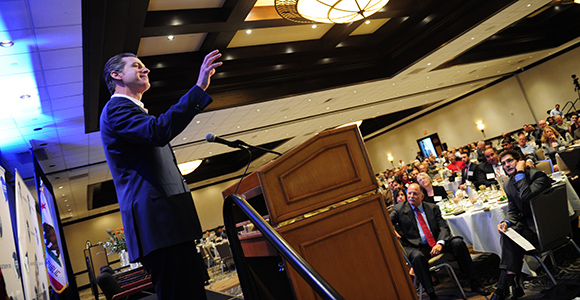
Lt. Gov. Gavin Newsom addresses the California Economic Summit in Ontario, California last week. (Photo Credit: Violeta Vaqueiro)
When California Forward and the California Stewardship Network conceived the California Economic Summit several years ago, it was hoped it could start a real conversation about job creation in California. Mission accomplished.
The fourth annual meeting of the Summit concluded last week in Ontario, attracting 400 private, public and civic leaders from diverse regions across California.
“Hundreds of public, private and civic leaders have worked tirelessly in the last year to find ways to improve our ability to create the right kind of jobs in California,” said James Mayer, president and CEO of California Forward. “At the Summit, we sharpened our strategies of how to create more jobs and more opportunity in more sustainable communities.”
Summit participants developed actionable plans on how California can address its infrastructure, housing, and workforce needs over the next 10 years, in order to meet the “Million Challenges” of one million more skilled workers, one million more homes and one million more acre-feet of water each year.
The 2015 Summit developed a number of goals to train more workers, build more homes and save more water. Among them are:
- To support state policies that will orient community colleges to prepare Californians for quality jobs and support regional coordination among colleges and employers.
- To work with the California legislature in 2016 to promote increased production and find ways to reduce costs for both market-rate and affordable housing
- To use Enhanced Infrastructure Financing Districts, which have long been advanced by the Summit, to fund regional water management that will conserve, capture, and reuse water.
“The California Economic Summit has achieved a proven track record of effecting real change and influencing policy,” said Eloy Ortiz Oakley, Superintendent-President of Long Beach City College and co-chair of the California Economic Summit Steering Committee. “The achievements thus far are a clear indication of the power in implementing a regional approach to solving some of the state’s toughest economic challenges.”
In advance of the annual convening, leadership released the Summit Playbook to provide additional information on the “One Million Challenges” and outline initial action plans that served to propel the regional collaboration that is at the heart of the Summit.
The Summit is composed of seven action teams: advancing manufacturing, capital, housing, infrastructure, regulations, workforce, and working landscapes. During the convening, these action teams, involving hundreds of Californians, laid the foundation for the work being done in the next year. Before the event concluded, action team members signed a commitment to work through the Summit for a shared prosperity in California.
Another example of how the Summit has grown is the events and personalities that it is attracting.
On Thursday, the California State Assembly Committee on Jobs, Economic Development and the Economy, (JEDE) held a hearing on the state’s role in building an inclusive economy.
JEDE Chair Assemblymember Eduardo Garcia thought the session was so good (and well-attended) that he promised to hold a JEDE hearing in association with the 2016 Summit, provided he is still chair of the committee.
Participating in the 2015 California Economic Summit were Lieutenant Governor Gavin Newsom, state Treasurer John Chiang, state Controller Betty Yee, Secretary of State Alex Padilla, UC President Janet Napolitano, and CSU Chancellor Timothy White, among others.
Holding this year’s Summit meeting in Ontario is another indication of the unique regional approach that the Summit takes. The Inland Empire would be the 25th largest state by population but often is overlooked in the behemoth of the greater Los Angeles area. It also has lagged behind other parts of California in the economic recovery of the past several years.
“California’s robust economic growth since the recession has not been spread equitably across all regions and communities. There are two Californias—one that does well—mostly around the coastal areas and another that lags, notably in the inland part of the state,” said Paul Granillo who is president and CEO of the Inland Empire Economic Partnership and co-chair of the Summit Steering Committee. “What we achieved at the Summit this week can help narrow that gap.”
Work on the issues continues year round.
The work, you see, never ends.

